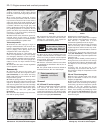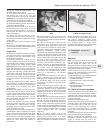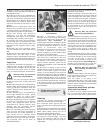
10 Turn the crankshaft to bring pistons 1 and
4 to BDC (bottom dead centre).
11 Unscrew the nuts from No 1 piston big-
end bearing cap. Take off the cap, and
recover the bottom half bearing shell (see
illustration). If the bearing shells are to be re-
used, tape the cap and the shell together.
12 To prevent the possibility of damage to
the crankshaft bearing journals, tape over the
connecting rod stud threads.
13 Using a hammer handle, push the piston
up through the bore, and remove it from the
top of the cylinder block/liner. Recover the
bearing shell, and tape it to the connecting
rod for safe-keeping.
14 Loosely refit the big-end cap to the
connecting rod, and secure with the nuts -
this will help to keep the components in their
correct order.
15 Remove No 4 piston assembly in the
same way.
16 Turn the crankshaft through 180° to bring
pistons 2 and 3 to BDC (bottom dead centre),
and remove them in the same way.
Inspection
17 Before the inspection process can begin,
the piston/connecting rod assemblies must
be cleaned, and the original piston rings
removed from the pistons.
18 Carefully expand the old rings over the
top of the pistons. The use of two or three old
feeler blades will be helpful in preventing the
rings dropping into empty grooves (see
illustration). Be careful not to scratch the
piston with the ends of the ring. The rings are
brittle, and will snap if they are spread too far.
They are also very sharp - protect your hands
and fingers. Note that the third ring may
incorporate an expander. Always remove the
rings from the top of the piston. Keep each set
of rings with its piston if the old rings are to be
re-used.
19 Scrape away all traces of carbon from the
top of the piston. A hand-held wire brush (or a
piece of fine emery cloth) can be used, once
the majority of the deposits have been
scraped away.
20 Remove the carbon from the ring grooves
in the piston, using an old ring. Break the ring
in half to do this (be careful not to cut your
fingers - piston rings are sharp). Be careful to
remove only the carbon deposits - do not
remove any metal, and do not nick or scratch
the sides of the ring grooves.
21 Once the deposits have been removed,
clean the piston/connecting rod assembly
with paraffin or a suitable solvent, and dry
thoroughly. Make sure that the oil return holes
in the ring grooves are clear.
22 If the pistons and cylinder liners/bores are
not damaged or worn excessively, the original
pistons can be refitted. Normal piston wear
shows up as even vertical wear on the piston
thrust surfaces, and slight looseness of the
top ring in its groove. New piston rings should
always be used when the engine is
reassembled.
23 Carefully inspect each piston for cracks
around the skirt, around the gudgeon pin
holes, and at the piston ring “lands” (between
the ring grooves).
24 Look for scoring and scuffing on the
piston skirt, holes in the piston crown, and
burned areas at the edge of the crown. If the
skirt is scored or scuffed, the engine may
have been suffering from overheating, and/or
abnormal combustion which caused
excessively high operating temperatures. The
cooling and lubrication systems should be
checked thoroughly. Scorch marks on the
sides of the pistons show that blow-by has
occurred. A hole in the piston crown, or
burned areas at the edge of the piston crown,
indicates that abnormal combustion (pre-
ignition, knocking, or detonation) has been
occurring. If any of the above problems exist,
the causes must be investigated and
corrected, or the damage will occur again.
The causes may include incorrect ignition
timing, or a carburettor or fuel injection
system fault.
25 Corrosion of the piston, in the form of
pitting, indicates that coolant has been
leaking into the combustion chamber and/or
the crankcase. Again, the cause must be
corrected, or the problem may persist in the
rebuilt engine.
26 On aluminium-block engines with wet
liners, it is not possible to renew the pistons
separately; pistons are only supplied with
piston rings and a liner, as part of a matched
assembly (see Section 9). On cast-iron block
engines, pistons can be purchased from a
Peugeot dealer.
27 Examine each connecting rod carefully for
signs of damage, such as cracks around the
big-end and small-end bearings. Check that
the rod is not bent or distorted. Damage is
highly unlikely, unless the engine has been
seized or badly overheated. Detailed checking
of the connecting rod assembly can only be
carried out by a Peugeot dealer or engine
repair specialist with the necessary
equipment.
28 On XU series engines, due to the
tightening procedure for the connecting rod
big-end cap retaining nuts, it is highly
recommended that the big-end cap nuts and
bolts are renewed as a complete set prior to
refitting.
29 On all engines, the gudgeon pins are an
interference fit in the connecting rod small-
end bearing. Therefore, piston and/or
connecting rod renewal should be entrusted
to a Peugeot dealer or engine repair
specialist, who will have the necessary tooling
to remove and install the gudgeon pins.
8 Crankshaft - removal and
inspection
4
Removal
Note: If no work is to be done on the pistons
and connecting rods, then removal of the
cylinder head and pistons will not be
necessary. Instead, the pistons need only be
pushed far enough up the bores so that they
are positioned clear of the crankpins.
1 With reference to Part A, B or C of this
Chapter, and earlier Sections of this Part as
applicable, carry out the following:
a) Separate the engine from the transmission.
b) Remove the timing chain/belt and
crankshaft sprocket.
c) Remove the sump - XU and TU series
engines.
d) Remove the oil pump.
e) Remove the clutch components and
flywheel/driveplate.
XV, XW and XY series engines
2 Unscrew and remove the bolts which hold
the crankcase half sections together. Split the
crankcase and keep the main bearing shells
with their crankcase web recesses if the shells
are to be used again.
3 Remove the crankshaft oil seal.
4 If the piston/connecting rod assemblies are
to be left in place, mark the big-end caps and
the connecting rods so that they can be
refitted in their original sequence and the
correct way round. Note that No 1 cylinder
liner is at the transmission (flywheel) end of
the engine.
5 Unscrew the big-end nuts and remove the
caps and lower big-end bearing shells.
6 Before removing the crankshaft it is
advisable to check the endfloat using a dial
gauge in contact with the end of the
crankshaft. Push the crankshaft fully one way,
Engine removal and overhaul procedures 2D•11
2D
7.11 Removing a big-end bearing cap and
shell
7.18 Using old feeler blades to assist
removal of the piston rings


















